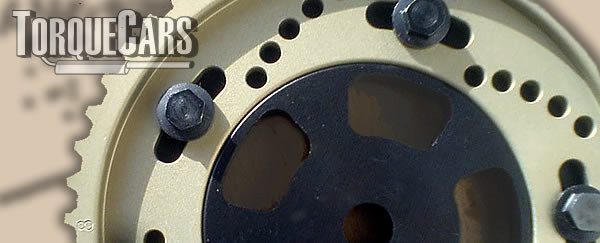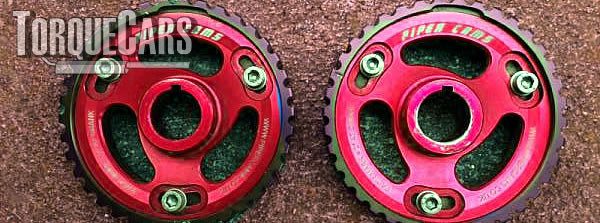Using Vernier pulleys
How to adjust the cam timing easily with vernier pulleys and setting them up.
It is essential to ensure that you line up the cam pulleys correctly with the cambelt. On standard cams and engines there is little need for adjustment or fine tuning.
A vernier pulley has a set of bolts around it that allow you to turn the pulley slightly so it is in line with a fraction of a tooth on the belt.
Why would you want to do this? Very small adjustments in the cam timing can alter the power band in your engine quite dramatically.
With the fine tuning on offer from vernier pulleys the power band can be raised, lowered and depending on where you move it to it may also have widened or shortened .
Your fast road cam may be introducing an annoying flat spot or raising the power band too high. A vernier pulley allows fine control over cam timing. (Duration is still controlled by the cam profile.)

Pulleys designed for tuning are generally fitted with marks to allow you to see the fine adjustment you are making. Generally each 1mm mark you move the pulley you change the cam timing by 2 degrees.
You are only controlling the time the inlet and exhaust ports open and close by doing this (you can't change the duration, just the start point). Ignition timing is down to the ECU and the cam profile sets the duration of lift.
This varies from engine to engine, pulley size and other factors so we can't make a rule of thumb here.
- With the cams removed from the head you'll need the TDC position.
- To start determine the TDC position of the engine with a piston top center tool. You'll also need a degree wheel bolted to the crank and a pointer to read the degree wheel.
- Rotate the crank until it stops on the Piston Top Center Tool. Note the marker position.
- Reverse the crank again until you hit a dead stop and note the marker position.
- Fit the cam and lock this in the TDC position but leave the vernier adjustment bolts loose with the bolts in the middle of the gap, which is usually the zero degree point!
- Fit and tension the belt and recheck the crank and cam are both at TDC, if they are then you can tighten the vernier bolts.
- Rotate the engine a couple of times and stop at the TDC mark (reading off the degree wheel on the crank). Hopefully the cams are still at TDC.
Now you can start to make those tiny adjustments on the vernier pulley. Loosen off the bolts and turn it in your chosen direction just 0.5 to 1 mm at a time.
NB: If you turn the pulley clockwise you will Retard the cam timing which you would do to improve top end power. Alternatively turn it anti clockwise to Advance the cam timing and moves the power band down the rev range.
Having spoken to many people it would seem that most people run up to 3 degrees difference. Again this depends on the cam profile chosen and engine type. Please avoid making large changes, you can do some serious damage to an engine by getting this wrong. Some engines are more forgiving than others.
Make a small adjustment, test it out thoroughly and use this as a baseline for further adjustment.

Getting the right settings is quite easy on a rolling road as adjustments can be done almost on the fly and a dyno reading will show where the power band is.
You'll need to take into account your gear ratio's and the cars natural power band.
For example in a high revving engine where there is a lot of top end power you won't see much gain advancing the timing to move the power band down.
Each type of engine has it's particular sweet spot.
Sometimes an adjustment works well on a hot engine but will lead to cold start issues. Expect to make some additional fine tuning adjustments the following day.
Most modern performance engines have twin cams, one for the intake and one for the exhaust. This allows a much finer degree of control and power optimization. As engines are so different we can't really provide a generic set of optimal settings for each cam.
To discuss all aspects of car tuning and share your own project and ideas please join our friendly international forum.
Please Check out my YouTube channel, we're regularly adding new content...
PLEASE HELP: I NEED YOUR DONATIONS TO COVER THE COSTS OF RUNNING THIS SITE AND KEEP IT RUNNING. I do not charge you to access this website and it saves most TorqueCars readers $100's each year - but we are NON PROFIT and not even covering our costs. To keep us running PLEASE Donate here
If you liked this page please share it with your friends, drop a link to it in your favourite forum or use the bookmarking options to save it to your social media profile.
Feedback - What do You Think?
Please use our forums if you wish to ask a tuning question, and please note we do not sell parts or services, we are just an online magazine.
Help us improve, leave a suggestion or tip
Please watch this video and subscribe to my YouTube channel.

 Click to accept YouTube Cookies & Play.
Click to accept YouTube Cookies & Play.